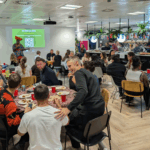Article written by Olivia Dodd, Associate Director for Client Success at The IN Group.
My role is to continually have conversations with business leaders who are looking to be more inclusive but don’t know where to start.
From prevailing attitudes to accepted terminology, it doesn’t help that so much about diversity, equity and inclusion changes so fast that we often struggle to keep up with it.
When the goalposts keep moving, it’s difficult to know where you should be kicking off. What do I tell these clients? Well, I often think the best way of approaching a complex, ever-changing challenge is to go back to basics. Start from scratch. So, I tell them to do what we did – start with your people.
Before you know where you’re going, you need to understand who you are
When we revamped our DEI committee 18 months ago, we conducted a survey with our staff to increase our understanding of our business’s makeup. Called “Identifying Who We Are,” the survey helped us understand the true nature of our diverse makeup – how we might not have been as diverse as we thought in some ways but were incredibly diverse in others. Just as importantly, this exercise has opened our eyes to how our people understand and view themselves. This was a critical signpost on our DEI journey.
For better or worse, everything about a person’s upbringing has helped them get to where they are now and is defining how they think about their future.
People are complicated and labels are limiting
Our approach was to allow our people to define themselves rather than limiting them to specific categories of self-definition that would hopefully paint an accurate enough picture.
Utilising enei’s (The Employers Network for Equality and Inclusion) resources, we surveyed our people on their protected characteristics – age, disability, gender reassignment, marriage and civil partnership, pregnancy and maternity, race, religion or belief, sex, and sexual orientation – and then asked each person to write a few sentences about how they actually identify. In describing themselves, it was interesting that our people chose to use a storyboard approach touching on the past, present and future.
An example would sound something like this: “I have come from a poor background and a family with a deep religious belief system, and that’s why I make sure I work extra hard to provide for my children so that they can have a better life than I did.” This is not a case of identifying as “poor” or “a religious person with low socioeconomic metrics,” but more associating that story with how they see themselves and live their life, today.
The meaning of equity
Once we understand our diversity, the next step is to ensure we’re being inclusive to this diverse group of people and their varying needs. At Investigo, we approached this by holding a series of Inclusivity Workshops for all teams across the business, featuring group exercises to help them learn something about themselves and their colleagues.
You take one step forward, I take two steps back
To demonstrate the meaning of equity and show that we don’t all start from the same point in life, I gave our participants a series of statements and asked them to take either a step forward or a step back, depending on their answer to each. Examples included:
- Take a step forward if, when you’re walking alone at night, you rarely feel threatened or in fear of sexual assault.
- Take a step forward if, when watching TV or going to the cinema, you can see your sexuality, race, religion or ability accurately and often portrayed.
- Take a step backwards if you have ever felt isolated in a room.
- Take a step backwards if you have ever been called names regarding your race, socioeconomic class, gender, sexual orientation, disability or neurodivergence, and it made you feel uncomfortable.
Specifically designed to be emotive, these statements led to a really interesting discussion that helped increase our understanding of each other and the shifting nature of inclusion. Inclusion’s not just a point you achieve in your life that you don’t ever need to revisit. It’s something that changes with you and your relationship with the world around you.
Inclusivity means different things to different people
This kind of discussion gets really challenging – and really productive – when you ask people how it feels to be in front of or behind their colleagues, from their personal lived experience. What do they think about the different positions their colleagues are in? Are participants surprised or do they feel it’s no big deal?
This exercise isn’t meant to instil guilt but rather to demonstrate the levels of discrimination across various categories. It shows us that we all have a relative level of privilege. The next step is to acknowledge it on a personal level. Doing so lowers defences, demonstrates vulnerability, and sets the tone for inclusive behaviours.
Inclusivity means different things at different times
How participants answer these questions may change during their lives, as discrimination and diverse associations are fluid.
Today, someone might be a white, 30-something, middle-class man. Yet tomorrow, they may be diagnosed with a neurodiverse condition – such as dyslexia – that automatically changes the way people see them. Or they might fall in love with a partner of a different ethnic heritage and experience discrimination against them, their partner and, in the future, their children. It might even be something out of the blue, like having a football injury, that results in them being classed as having a disability.
Changes in our lives alter our relationship with the world around us and other people’s perceptions of us. Inclusivity in life ebbs and flows according to what happens to us and the decisions we make that also change what might happen to us.
That’s when we can take advantage of our privileges to benefit others – by bringing them to the table, fostering an equitable workplace, being an ally and speaking out against injustices.
The impact of work and our inter-relational responses
What do we mean by inter-relational responses, you might be wondering? This is about how we relate to those we work with, how the past might impact the way we connect and clash, and how we process both the ruptures and repairs we create. We spend so much time at work that the relationships we build, the experiences we gain, and the way in which we respond to conflict or a potential fear of disconnection, are profound. We shouldn’t underestimate the impact we have on those we work with. This impact is felt not just in the present day but, more importantly, in the future, based on our inter-relational dynamics.
Our value of inclusivity
Let’s explore the notion that inclusivity means something different to each individual. You may find, as we did during our workshops, that some people don’t think this conversation is for them, especially those who would class themselves as white, heterosexual and able-bodied. However, it’s important to make people think about what inclusion means to them personally. It might be to have a voice and be heard; to be respected; or to come to work as their authentic self. These are statements that apply to people of any gender, background, race, or socioeconomic group. They’re our basic social needs as human beings.
Considering workplace comments and microaggressions
What would make you take a job at an organisation where you know the level of inclusivity is not where it needs to be? We asked our teams to imagine they were making a decision on a job offer on behalf of a loved one, based on comments overheard in the workplace – some of them apparently more inclusive than others. If they wouldn’t accept the job for a loved one, would they accept it for themselves? Would they overlook the organisation’s inclusivity issues if remuneration were a factor? What if some statements were a one-off and not an accurate reflection of the organisation’s wider culture?
This all serves to highlight our differing perceptions of inclusion. We’re all in different situations in our lives, and we all have different rationales for making decisions. These criteria might even change at different points in our lives. By being self-aware and challenging our own thinking, we can actively foster inclusive environments that are positive places to be – not just for us but for everyone.
Where does this leave us?
No one’s experience of the world is exactly the same as anyone else’s, and no one’s life circumstances are static. Our circumstances change, and therefore, so does our relationship with diversity. This realisation has been a crucial part of our work on DEI at Investigo.
We’ve found that our approach has been incredibly useful as a business, particularly by bringing our teams together and helping them think about things a little differently. But every business is different, and so are its people. While there’s no one approach that will work for every business, our story can easily be replicated or adapted to suit your business’s needs and your position on your DEI journey.
There’s a saying that you should treat others the way in which you wish to be treated. I have to disagree. I believe you should treat others how they want to be treated. That’s when we can truly show that we not only understand ourselves but are working hard to understand each other.
Share this:




